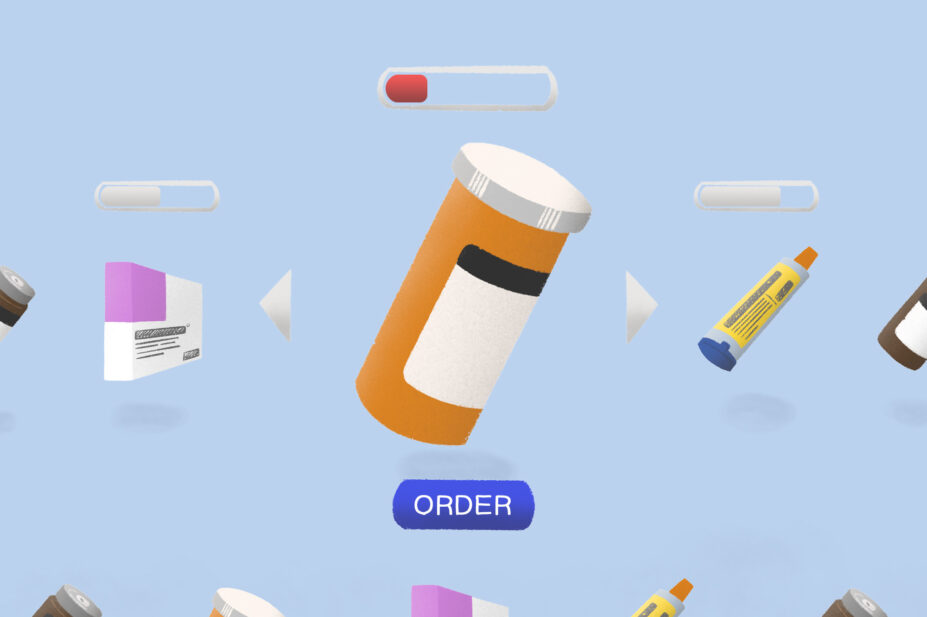
Wes Mountain/The Pharmaceutical Journal
“My pharmacy doesn’t have my prescription medicine, so what do I do now?”
This question will have been asked many times by patients, for one-off medicines or by those who have repeat prescriptions on a cyclical basis.
In 2022/2023, 1.18 billion prescription items were dispensed in the community in England at a cost of £10.4bn[1]. People living in England and the rest of the UK rely on the pharmaceutical supply chain to provide medicines and when these are not available it can cause anxiety and additional pain, undermining quality of life in many ways. The prevalence of medicines shortages continues in the UK and has a continuous global footprint. As of February 2023, there were reportedly 101 medicine shortages in the UK, double that of February 2022[2]. There is no clear cessation of this issue on the horizon.
So, when a patient cannot receive their prescription, what do they do? And what impact does it have on them?
When considering this, I consulted with two patients who take regular medication but have had to face and cope with medication shortages.
Claire* has particular difficulties accessing medicines for her type 2 diabetes mellitus (liraglutide injection) and ADHD. Both medications have been unavailable for some time. As a result, Claire rations her ADHD medication, using it sparingly for maximum effect on working days, when she needs to be more focused, but then must cope with the mood and condition fluctuations that come with this. Claire has also been advised that the absence of liraglutide has been caused by off-licence prescribing and has had to switch to other products, which caused unwanted side effects. She was hospitalised owing to medication-related issues in October 2023.
Sarah* was prescribed strong antibiotics, but her local pharmacy did not have them in stock. She was advised to try another pharmacy and finally got her prescription filled on her fourth attempt.
Medicines should always be available for patient consumption, but waiting for this to happen is unrealistic
Both patients are tenacious in their efforts to get their prescriptions and have felt empowered to speak with healthcare professionals about this but they deserve better from our healthcare system. The completion of their treatment happens because they have taken on the personal responsibility of finding their medicines. They are effectively the ‘last mile’ of their healthcare delivery; however, both are concerned at the inequity this causes, with other patients who are immobile or who face financial difficulties less able to ‘hunt down’ their medications.
Medicines should always be available for patient consumption, but waiting for this to happen is unrealistic. What can we do to support greater access for patients to medication when we always have these disruptions in our supply chains?
A stock information network
At a Health and Social Care Select Committee meeting in January 2024, the ‘Argos’ system of checking stock availability was referred to as an exemplar[3,4]. If we used this type of business-to-consumer system, a patient could log into a website, choose the product they want, reserve and pay for it and then collect when ready. This could be further supported by text or email communication.
Having an accessible online platform that advises patients of medicine availability before they travel to a pharmacy is one way of reducing stress and strain. At the point of searching, it would be apparent if a pharmacy did not have the necessary product and then the patient could contact their GP to discuss alternatives.
Another course of action would be a business-to-business system where pharmacies could connect and search for ‘live’ stock. Such a system exists as a private commercial enterprise in Spain. Luda Partners is a digital network of pharmacies that facilitates communication between sites to locate out-of-stock medicines[5]. With 3,500 pharmacies connected across the country, LUDA pharmacies can check stock availability and direct patients to pharmacies that have their medication and offer web sales of non-medical products. Owing to this level of stock transparency, shortage signals can be sensed earlier and actioned. If this venture exists in Spain, could it be introduced across England’s 10,558 community pharmacies[6]?
In Sweden, the FASS platform offers another digital solution, offering healthcare professionals and patients a medicines support system. Using a dedicated app, patients can scan a leaflet to determine if their medicines are available at their pharmacy[7].
A similar website — Bot Plus — exists in Spain, providing information on medicines and active ingredients[8]. As well as holding additional information on products and therapeutic use, it also reports on supply issues to pharmacists. Content is informed by that published by the Spanish Agency for Medicines and Health Products (AEMPS). Data can be conveniently access via an app.
The adoption of such platforms in the UK could support pharmacy teams to deliver their services by providing a single source of real-time information on medicine availability that they can discuss with their patients, improving their experience.
Pharmacies as medicine suppliers
Stock availability could also be supported by a medicine buyer-supplier forum, akin to eBay.
This would be operationally beneficial as pharmacies could input stock for sale on a protected portal, from which other pharmacies could make purchases. Stock for sale could be unwanted excess stock or stock with a short shelf life. In the face of shortages, platforms and practices such as these could reduce the impact of stock unavailability by circulating existing stock between different sites.
The creation of all these solutions would be simpler if we only had one pharmacy chain in the UK
This system would be a natural progression of ‘mutual aid’ practices that were permitted during the COVID-19 pandemic, when regulations were relaxed allowing NHS pharmacies to sell stock to one another to treat patients within specific operational constraints[9]. This encouraged optimal medication use and enabled enhanced service delivery. Although desirable for pharmacists, this practice supports occasional supply issues and not normal business activity. Currently, when needed, pharmacists in the UK are sourcing stock from other pharmacies in a more ad hoc, informal manner via telephone calls or Whatsapp groups[10].
Implementing solutions
The creation of all these solutions would be simpler if we only had one pharmacy chain in the UK. However, implementing them across the current market would require thousands of pharmacies to independently commit to sharing information about their supply chains, challenging broader commercial sensitivities around medicines supply. Government intervention and support would also be required.
Improving information solutions to support greater access to medicines stock held within the UK has been discussed in various forums to date: in 2019 at a stakeholder event at the University of Bradford and again at a Royal Pharmaceutical Society roundtable meeting with chief pharmacists in 2023[4,10].
Following the COVID-19 pandemic, we are all much more digitally aware and familiar with technological solutions, and we embrace the access and convenience that comes with this. Pharmacists would welcome this additional inventory insight and patients would like to relinquish the shuffling between pharmacy sites searching for medicines.
In creating and implementing patient resources, we have to avoid increasing digital exclusion. There should be alternative means of accessing medicines availability information within pharmacy sites, such as the use of touchscreen facilities that provide this detail (again, very similar to the Argos digital platforms).
There is no denying that disruptions in our supply chains will continue. In the face of this challenge, patients need to have better information regarding medicines availability in our pharmacies. Pharmacy teams go above and beyond in their roles to look after their patients, some reaching out to find medicines for them, others asking patients to do this themselves. Like patients, they also take on additional responsibility to source medicines when disruptions occur.
With the threat of more community pharmacy closures[11], it is more important than ever to support patient access to medicines from the current pharmacy network; enhanced digital platforms can facilitate this. These suggested digital solutions could effectively support pharmacies and patients, or at the very least they could take us one step closer.
*Names have been changed
- This article was amended on 18 April 2024 to correct the number of prescription items dispensed in the community in England in 2022/2023
- 1Prescription Cost Analysis – England – 2022-23. NHS Business Services Authority. 2023. https://www.nhsbsa.nhs.uk/statistical-collections/prescription-cost-analysis-england/prescription-cost-analysis-england-2022-23#:~:text=Key%20findings (accessed April 2024)
- 2Mahase E. Surge in drug supply problems reflects lack of government insight, says industry leader. BMJ. 2024;q467. https://doi.org/10.1136/bmj.q467
- 3Health and Social Care Committee Tuesday 16 January 2024 . Parliamentlive.tv . 2024. https://parliamentlive.tv/event/index/549ac412-bb4f-48f8-9758-eaca62788652 (accessed April 2024)
- 4Designing a more resilient system for medicines supply in the UK. Pharmaceutical Journal. 2023. https://doi.org/10.1211/pj.2023.1.184772
- 5Luda Partners. EU Startups. https://www.eu-startups.com/directory/luda-partners/#:~:text=LUDA%20Partners%20is%20the%20digital (accessed April 2024)
- 6Pharmacy Openings and Closures – PHARMACY_OPENCLOSE_202402 – Open Data Portal BETA. NHS Business Services Authority. 2024. https://opendata.nhsbsa.net/dataset/pharmacy-openings-and-closures/resource/f1a0d1bd-9d49-4241-9c21-f9e6670b570e (accessed April 2024)
- 7FASS app. FASS Allmänhet . https://www.fass.se/LIF/startpage?ignoreHandleMobile=true&userType=2 (accessed April 2024)
- 8BOT PLUS app: new design, functionalities and information on all marketed medicines. Consejo General de Colegios Farmaceuticos . 2023. https://www.farmaceuticos.com/noticias/bot-plus-app-nuevo-diseno-funcionalidades-e-informacion-de-todos-los-medicamentos-comercializados/ (accessed April 2024)
- 9Repeal of wholesale dealer licence exemption for pharmacists. Medicines and Healthcare Products Regulatory Agency . 2014. https://www.gov.uk/government/publications/repeal-of-wholesale-dealer-licence-exemption-for-pharmacists (accessed April 2024)
- 10Medicines Availability in the UK Pharmaceutical Supply Chain. University of Bradford, School of Pharmacy and Medical Sciences. 2019. https://www.bradford.ac.uk/pharmacy-medical-sciences/research-innovation/medicines-availability/ (accessed April 2024)
- 11MPs write to Health Minister amid 1,400 pharmacy closures. Community Pharmacy England. 2024. https://cpe.org.uk/our-news/mps-write-to-health-minister-amid-1400-pharmacy-closures/ (accessed April 2024)


